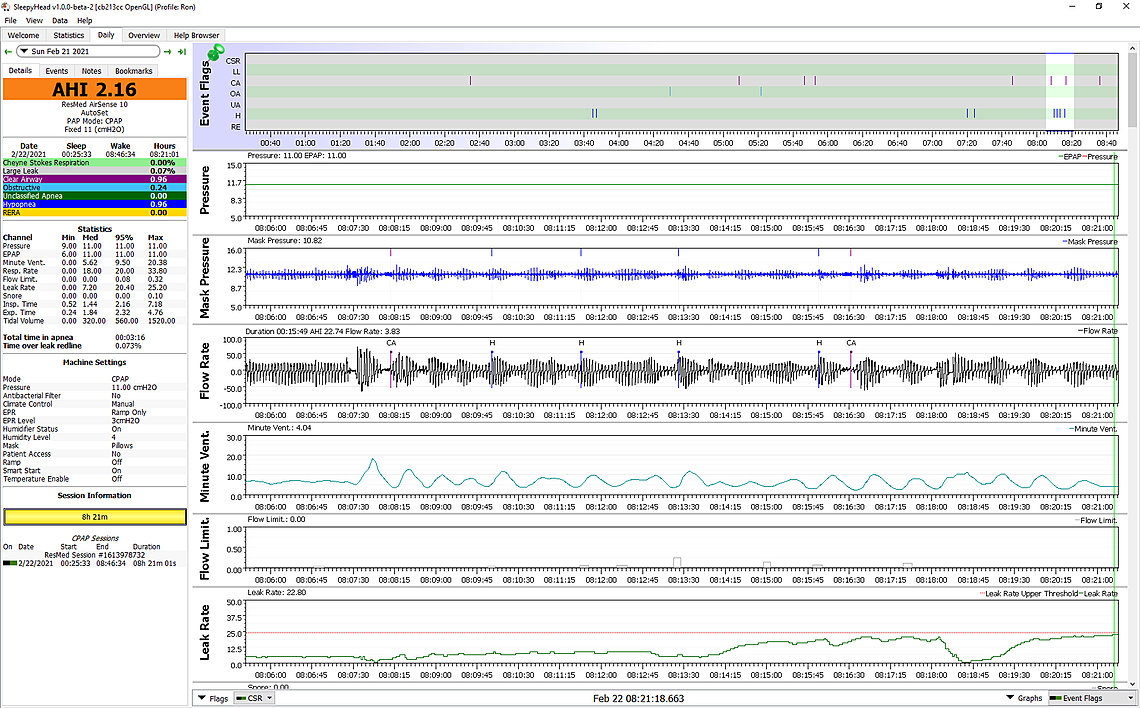This daily report is not as good as the previous one. It indicates more of a problem with central apnea (CA events), and minimal obstructive apnea (OA events). You will have to watch if increasing pressure that CA's don't become a problem. Hypopnea (H) is high as well. This graph looks quite a bit like mine where I tend to have issues with CA events and even more with Hypopnea. I have concluded that my hypopnea events are generally central in nature. In other words they are dropping respiratory effort rather than a flow limitation due to obstruction. It is generally assumed that hypopnea events are restrictive in nature, but that is not always true. Here is a night that is a good example of what I am talking about.

This is a close in zoom of the portion of the night where there is a series of 7 events in fairly close succession. Only six are flagged, but the initiating event is an obstructive one which disrupted breathing. It does not last long enough to be flagged, but you can see how it upsets minute ventilation and causes is to start cycling. You can also see the impact on the mask pressure. The short but wide blue band in the mask pressure indicates it is obstructive. The band is the machine cycling flow to see what impact there is on pressure. A CA event paints a more narrow pressure band because the airway is open, not closed. This first obstructive event starts the cycle and results in a clear CA event where breathing stops but the airway is open. This is followed by some less severe cycles in flow that are flagged as hypopnea events. The cycle is almost identical in nature to the one flagged as a CA, but does not go to zero flow so is not flagged as a CA event. The last event is a clear CA one where the flow goes to zero, and the mask pressure paints a narrow band. The cycling continues after this but eventually dies out.
For these reasons I consider most of my hypopnea events as central apnea in nature. I you zoom in and look at your events in detail you may be able to do a similar diagnosis . Those green PB areas are a further indication of this same problem.
So what do you do? If you find this pattern frequently (higher CA and H), then you should do what you can to keep pressure down. One way to do that is as I suggested to turn FLEX off. Flex reduces pressure on exhale. Obstructive events can happen on exhale and a lower exhale pressure can initiate obstructive events. If you turn FLEX off this drop in pressure is avoided, and in your case you get 9 cm on inhale and exhale. With respect to you feeling pressure in your ears I would suspect some congestion issues. I use Otrivin occasionally to reduce congestion. It should not be used on an ongoing basis. In the scheme of things 9 cm is not a high pressure. Some use pressures up to 25 cm. I have mine set at 11 cm with no reduction on exhale (EPR turned off). My thoughts remain the same. Try turning off FLEX to see if this helps. If it does, then you might even want to try a lower pressure than 9 cm. Generally one could reduce the pressure until OA events become the dominant component of the AHI.
On the mask leaks, I think you are doing fine. I would set the Leak Rate red line. Right click on the vertical scale, select Dotted Lines, and then check the Leak Rate Upper Threshold box. I also use the Y-Axis option, and then use Manual Override to set the minimum at 0 and max at 50 L/min.
I hope that helps some. If you have any questions, just ask. Based on this latest Daily Report you do not have a simple basic case of Apnea. It looks like complex apnea. That said a basic CPAP with a fixed pressure may be the best way of addressing it. At least it is the best first try.